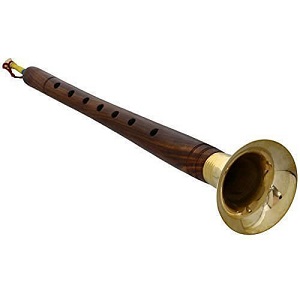Shehnai
 The Shehnai is a historic instrument of northern Indian (known as Oboe Hindu), used in classical music as in the folk. It is made up of a body of wood to which he inserts a mouthpiece which contains a double tongue, ends with a bell metal. The shehnai is a aerophone which is thought to attract good luck, and as a result, is widely used in northern India for marriages and processions.
The Shehnai is a historic instrument of northern Indian (known as Oboe Hindu), used in classical music as in the folk. It is made up of a body of wood to which he inserts a mouthpiece which contains a double tongue, ends with a bell metal. The shehnai is a aerophone which is thought to attract good luck, and as a result, is widely used in northern India for marriages and processions.
The Shehnai is also called the oboe in northern Indian. It may have evolved since the Persian Nay. There are representations of Nay on Egyptian tombs dating to 3000 BC Historically, in India, Shehnai was one of nine instruments associated with the sets of royal courts.
It's called Mangal Vadya, which translates to "enabling tool." The sound of enabling Shehnai is why it is associated with religious ceremonies. Today, the Shehnai is still playing in temples. This condition has done a necessary tool in Indian weddings and festivals in the north.
he Shehnai is a wooden conical body on the outside and inside, with a bell nickel-plated metal. The Shehnai has eight holes and a double reed oboe or external similar to a small vegetal for breath. The tongue is inserted into the conical peak metal (Tudel), then this set is inserted into the body of wood together with the hood. This instrument has a sealed chamber of air. When running, the lips are placed on the upper mouth, this is to put the cane inside the mouth. The mouth is now part of the instrument and acts as a air chamber.